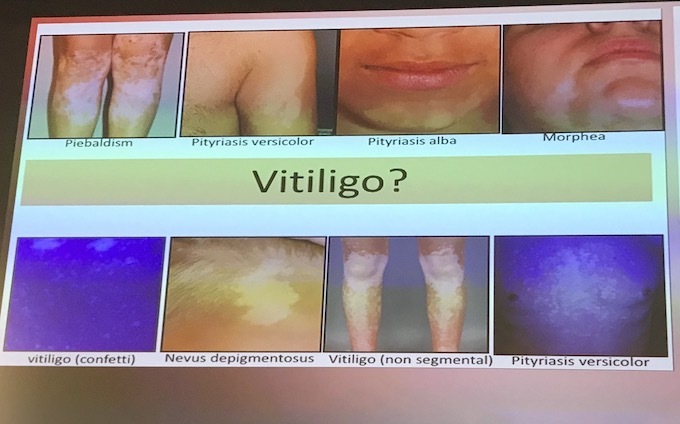Our work is entirely funded by private donations – we receive no money from government. Your money will help us continue funding research into vitiligo and supporting people affected by the condition.
FAQ
Vitiligo is a common skin condition with characteristic milky white patches of irregular shape. However, several other skin conditions exhibit similar symptoms that can lead to a misdiagnosis of vitiligo.
Broadly speaking, loss of skin pigmentation is called leukoderma. Vitiligo is a specific type of leukoderma and is often, though incorrectly, used interchangeably with the term leukoderma.
Thermal burns, inflammatory skin disorders like psoriasis, or bacterial infections like leprosy may cause a reversible loss of skin color. Genetically determined diseases like piebaldism can also create distinctive patterns of milky white skin and hair, which can be mistaken for vitiligo. Furthermore, loss of skin color can be caused by contact with chemicals known to destroy the skin pigment cells. These are usually chemicals found in the workplace, but also in certain cosmetic products. This skin condition is known as chemical, or contact, leukoderma.
Here are some of these conditions and how they differ from vitiligo:
- Tenia versicolor (also Pityriasis versicolor): this is caused by fungal infection, which can develop due to oily skin and poor personal hygiene, especially in warm and humid surroundings. School-age children are often affected by this condition. It presents iteslf commonly on the cheeks, face and neck in the form of white patch with fine dry scaly surface of the skin.
- Pityriasis Alba: a white patch on children's face is commonly seen in cold months. Severe cases are rare, and they require attention of a dermatologist. Generally, boys are more affected than girls.
- Piebaldism: this is a rare genetic disorder present at birth, characterized by the absence of melanocytes from the part of the skin, with a sharp, clear edge. A flock of white hair often marks the forhead. This is mostly an incurable condition.
- Idiopathic guttate hypomelanosis: multiple rounded, light colored patches that appear on the exposed body parts may resemble a confetti-like vitiligo, but they ain't it. This condition is more common among peope over 40 years than early-to-mid ages.
- White scars: the scar from an earlier skin injury may leave a white spot after healing. At times it may look like vitiligo and it is notoriously difficult to treat.
- Leprosy: this is a bacterial infection of the skin that cause light shade patches with loss of sensation and hair above them. It is rarely encountered in the Western part of the world and is curable.
- Chemical leukoderma: exposure to certain chemicals may cause distinctive white patches on the skin that have vitiligo-like appearance. This condition is usually self-reversible within several months or can be successfully treated.
- Halo nevus: it is a kind of mole inside a depigmented circle. The exact cause of developing Halo nevus is unknown. It often serves as an early warning for vitiligo and doesn't require a treatment. More about Halo nevus
A well-trained dermatologist should be able to distinguish vitiligo from more than twenty conditions with similar skin appearance.

A slide from presentattion "Differential Diagnosis of Vitiligo" by Prof. Nanja van Geel. Vitiligo session at IMCAS, January 2020
Suggested reading: Which diseases most commonly accompany vitiligo?
FAQOther Questions
- Can Ginkgo Biloba help with vitiligo?
Ginkgo Biloba seems to be a simple, safe, inexpensive and fairly effective therapy for vitiligo. It is mostly effective in halting the progression of the disease. It can also sp...
- Is there a traditional medicine to treat vitiligo?
Traditional medicines may be helpful in chronic, metabolic, and stress-related conditions early in the disease manifestation, before extensive tissue and organ damage has occurr...
- Isn't it just a cosmetic disorder?
Contrary to popular belief, vitiligo is not a cosmetic disorder but a systemic disease affecting the largest body organ and other vital systems, with multiple comorbidities. Fo...
Though it is not always easy to treat vitiligo, there is much to be gained by clearly understanding the diagnosis, the future implications, treatment options and their outcomes.
Many people deal with vitiligo while remaining in the public eye, maintaining a positive outlook, and having a successful career.
Copyright (C) Bodolóczki JúliaBy taking a little time to fill in the anonymous questionnaire, you can help researchers better understand and fight vitiligo.